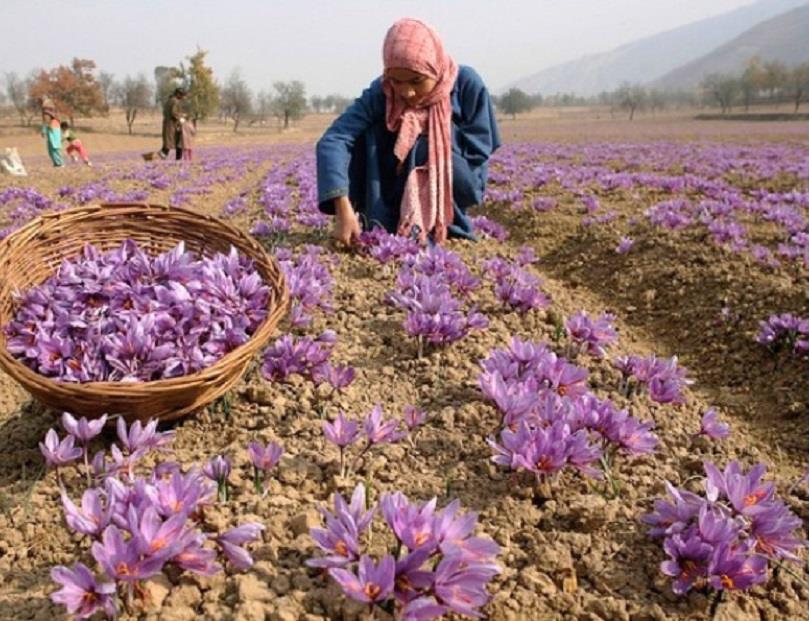
Can Innovation Save Kashmir's Saffron From A Warming Future?
File photo
By Mohammad Hanief
The autumn harvest no longer brings the same comfort it once did in Kashmir's saffron town. The fields that earlier bloomed like a crimson quilt have now thinned. Families for generations built their lives around this delicate flower that gave Kashmir its name: the land of red gold. Today, the yields tell a different story.
Production has slipped from around eight metric tons annually to less than three. The shift is a direct consequence of climate stress: unseasonal warmth, delayed monsoons, and winters that fail to deliver the chilling period saffron needs to flower. Even a few misaligned days of temperature or rainfall can erase months of painstaking labour.
ADVERTISEMENTSaffron is famously sensitive. The plant thrives within narrow climatic thresholds. Flowering requires cool autumn nights, moderate rainfall, and soil that remains neither too wet nor too dry. Rising temperatures in the last five years, coupled with erratic precipitation, have disrupted these delicate cycles.
Farmers recount years where flowers emerged unevenly, leaving entire plots unproductive. In 2025, the climate seems to conspire against tradition, turning a once-reliable harvest into a precarious gamble.
Urbanization compounds these climatic pressures. Pampore's fields are gradually being encroached upon by roads, housing projects, brick kilns, and infrastructure development. Fertile farmland shrinks year by year, forcing families to cultivate smaller areas while maintaining the same labour-intensive practices. Soil erosion, declining water tables, and altered drainage patterns have worsened conditions. Every lost acre translates directly into lower output and reduced income.
Farmers are responding with innovation. Controlled indoor cultivation allows temperature, moisture, and nutrient supply to be monitored precisely, shielding plants from weather extremes. Aeroponic farming, which grows saffron in a mist environment without soil, conserves water and reduces dependency on fragile land.
These approaches remain experimental, but early results are promising. Families who can afford the investment are seeing higher yields and more consistent quality.
Ecological threats have begun to influence outcomes as well.
Indian crested porcupines, once confined to forests, now raid saffron plots, feeding on corms and damaging flowers. Deforestation and habitat loss have driven wildlife into agricultural spaces, adding unexpected costs to already stretched budgets. Farmers spend more on fencing and pest control, increasing production costs while revenues dwindle.
Government programs have attempted to respond. In the last five years, initiatives have promoted modern farming techniques, offered subsidies for controlled cultivation, and trained farmers in soil and water conservation. Authorities have sought to protect farmland from encroachment and provide financial support for crop losses.
Despite these measures, adoption remains uneven. For many smallholders, the cost of technology, paired with traditional expectations of cultivation, presents a difficult choice.
The economic stakes are high. Saffron supports thousands of families and a network of local workers involved in drying, grading, packaging, and selling the spice. Reduced yields erode household incomes, threaten employment, and weaken Kashmir's presence in global saffron markets.
The premium status of Kashmiri saffron, valued for its aroma, colour, and delicate flavour, means that even small reductions in quality can sharply affect prices and consumer confidence.
Cultural preservation adds another dimension. Saffron is woven into Kashmir's identity. Its red stigmas flavour local dishes, medicinal remedies, and artisanal crafts. They appear in wedding rituals, festive dishes, and traditional remedies. Losing saffron would mean losing a living thread of cultural heritage. Protecting these fields is a fight for identity, history, and tradition.
Farmers are increasingly blending tradition with science. Generational knowledge still guides planting, harvesting, and corm selection, but new techniques in water management, soil enrichment, and controlled environments are becoming essential.

Legal Disclaimer:
MENAFN provides the
information “as is” without warranty of any kind. We do not accept
any responsibility or liability for the accuracy, content, images,
videos, licenses, completeness, legality, or reliability of the information
contained in this article. If you have any complaints or copyright
issues related to this article, kindly contact the provider above.




















Comments
No comment